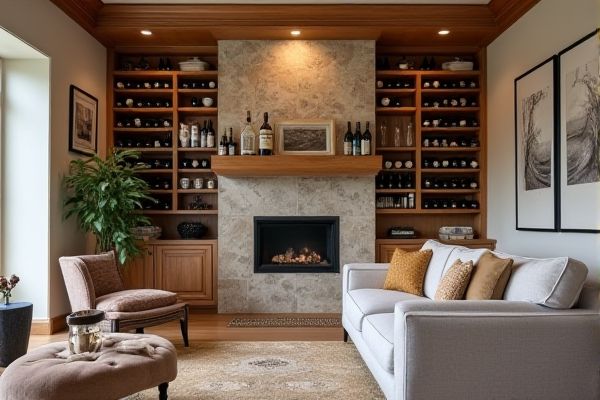
Integrated wine racks seamlessly blend into your cabinetry, offering a sleek, space-saving solution that enhances your kitchen or living area's aesthetic. Discover the key differences and benefits of both options by reading the rest of the article.
Table of Comparison
| Feature | Integrated Wine Rack | Freestanding Wine Rack |
|---|---|---|
| Installation | Built into cabinetry or walls, requires professional fitting | No installation needed; portable and easy to move |
| Space Efficiency | Maximizes existing space; ideal for small areas | Requires dedicated floor or counter space |
| Capacity | Varies; custom sizes allow large storage | Varies from small racks to large units |
| Design | Seamless, built-in aesthetic; matches home decor | Varies widely; styles from rustic to modern |
| Mobility | Fixed, not portable | Highly portable and flexible placement |
| Cost | Higher initial cost due to installation and customization | Generally affordable; no installation required |
| Durability | Typically built with high-quality materials for longevity | Depends on material; some less durable options available |
| Best Use | Permanent, elegant wine storage integrated into home design | Flexible, temporary, or supplemental wine storage |
Overview of Integrated and Freestanding Wine Racks
Integrated wine racks are built directly into your home's cabinetry or walls, offering a seamless and space-saving solution ideal for personalized wine storage. Freestanding wine racks provide flexible placement options, allowing you to easily move or expand your collection without permanent installation. Your choice depends on available space, design preferences, and ease of access to your wine collection.
Design and Aesthetic Appeal
Integrated wine racks offer a sleek, built-in look that seamlessly blends with cabinetry and enhances modern kitchen design by providing a cohesive, minimalist aesthetic. Freestanding wine racks provide versatile placement options and often serve as statement pieces with various styles, ranging from rustic wood to industrial metal, catering to diverse interior decor preferences. The choice between integrated and freestanding racks depends on spatial flexibility and desired visual impact within the living environment.
Space Utilization and Storage Capacity
Integrated wine racks maximize space utilization by seamlessly fitting into cabinetry or walls, offering a sleek, built-in storage solution that can be customized to your kitchen's dimensions. Freestanding wine racks provide flexible placement options and can vary greatly in storage capacity, but often require more floor space compared to integrated models. Choosing between the two depends on your available space and desired storage volume for wine bottles.
Installation Requirements
Integrated wine racks require precise cabinetry design and professional installation to ensure a seamless fit within kitchen or bar units, offering a built-in aesthetic that maximizes space efficiency. Freestanding wine racks offer flexibility with minimal installation, allowing you to easily relocate or adjust their placement without structural modifications. Your choice depends on whether you prioritize a custom, permanent setup or versatile, plug-and-play convenience.
Flexibility and Mobility
Integrated wine racks offer a sleek, built-in design that maximizes kitchen or cellar space but lack flexibility due to their permanent installation. Freestanding wine racks provide superior mobility and can be easily relocated, accommodating changing storage needs or room layouts. Choosing between the two depends on whether fixed placement or adaptable storage solutions are prioritized.
Temperature and Wine Preservation
Integrated wine racks offer superior temperature control and consistent humidity levels by being built into climate-controlled cabinetry, which helps preserve the wine's quality over time. Freestanding wine racks lack this insulation, making them more susceptible to temperature fluctuations and environmental changes that can compromise wine preservation. Choosing an integrated wine rack enhances your collection's aging potential by maintaining optimal storage conditions.
Cost Comparison
Integrated wine racks typically involve higher upfront costs due to custom cabinetry and installation fees, often ranging from $1,000 to $5,000 depending on materials and design complexity. Freestanding wine racks are generally more affordable, with prices starting at around $50 for basic models and going up to $1,000 for premium or larger units made from high-quality wood or metal. Long-term value considerations include integrated racks enhancing home aesthetics and resale value, while freestanding racks offer portability and no installation expenses.
Suitability for Different Home Styles
Integrated wine racks seamlessly blend into modern and contemporary home designs, providing a sleek and built-in appearance that complements minimalist aesthetics. Freestanding wine racks offer versatility, fitting well in eclectic, rustic, or traditional styles where mobility and statement pieces are desired. Your choice should consider how the wine rack enhances the room's architecture and functionality while matching your home's decor theme.
Maintenance and Cleaning
Integrated wine racks require less frequent cleaning as they are often built into cabinetry, providing better protection from dust and spills. Freestanding wine racks need regular dusting and occasional wiping to prevent buildup, especially in open environments. Your maintenance effort will largely depend on the location and material of the rack, with integrated options offering a more low-maintenance solution.
Choosing the Right Wine Rack for Your Needs
Integrated wine racks offer a sleek, built-in storage solution that maximizes space efficiency and enhances your kitchen or dining area's aesthetic. Freestanding wine racks provide flexibility and portability, allowing you to easily relocate or expand your collection without permanent installation. Consider your available space, collection size, and style preferences to choose the perfect wine rack that suits your storage needs and complements your home decor.
 homyna.com
homyna.com